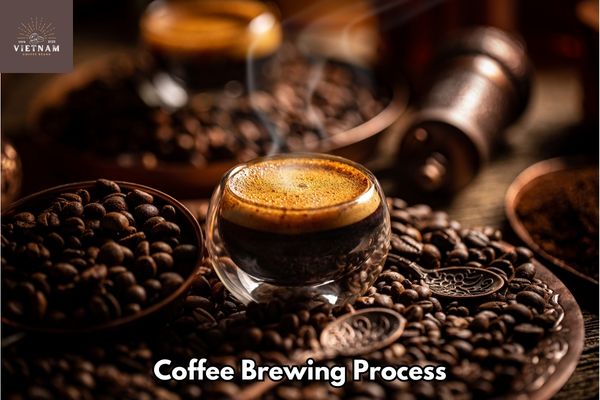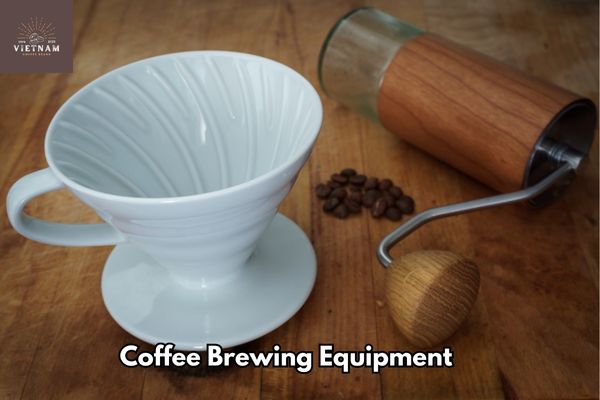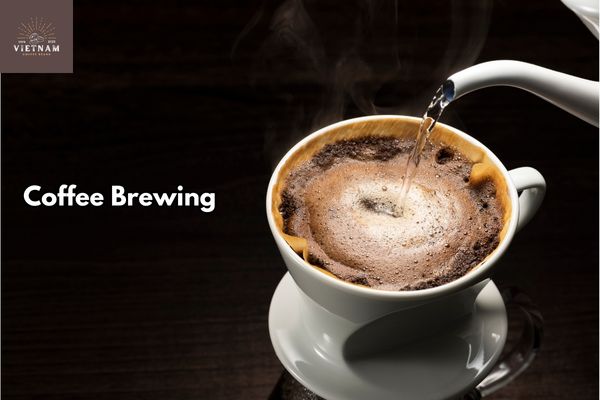As a coffee connoisseur, I know it takes more than just a few scoops of ground beans to make a great cup of joe. Brewing coffee is an art form that requires the right technique, equipment, and ratios.
In this article, I’ll explain the Coffee Brewing process, different methods, equipment, and machines, and show you how to determine the perfect coffee to water ratio. Let’s get brewing with us!
Key Takeaways
- Boiling water is essential for brewing great coffee.
- The ideal water temperature is 195 to 205 degrees Fahrenheit.
- Steeping methods include filter, beans, and pour-over.
- The strength and flavor of coffee can be influenced by the filtration method and brewing time.
Coffee Brewing Process

As a coffee enthusiast, I understand the importance of the brewing process. Boiling, steeping, filtration methods, and pressure are all important considerations when crafting your perfect cup of coffee. From French presses to espresso machines, the brewing process is an art form that requires skill and experience to perfect.
Boiling
Boiling water is essential for brewing great coffee; it’s the foundation of the brewing process. Heat the water to just below the point of boiling, as boiling water tends to burn the coffee grounds. The temperature of the water should ideally be between 195 to 205 degrees Fahrenheit.
Getting the temperature right is essential for getting the best flavor and taste out of the coffee. Once heated, pour the water over the grounds and let it steep for a few minutes. This process will extraction the flavor and taste from the coffee grounds into the boiling water. Once done, the boiled water is now ready to be used to make coffee.
Steeping
After heating the water, let it steep for a few minutes to extract the flavor and taste from the coffee grounds into the water. Steeping coffee is a simple process that can be done with a few different methods, such as:
- Filter:
- Place the ground coffee in a filter.
- Pour hot water over the coffee, saturating all the grounds.
- Wait for the water to pass through the filter.
- Beans:
- Place the beans in a container.
- Pour hot water over the beans.
- Let it sit until it reaches the desired temperature.
- Pour Over:
- Place the ground coffee in a filter.
- Slowly pour hot water over the grounds, wetting them evenly.
- Keep pouring until all the coffee grounds are saturated with the hot water.
The temperature and grind of the coffee beans will affect the flavor of the coffee, so it’s important to be mindful of the temperature and grind when steeping. Steeping is a cost-effective and simple way to make a delicious cup of coffee.
Filtration Methods
Filtration is a key part of the coffee-making process, with various methods used to extract the desired flavor and taste from the grounds.
| Drip Coffee | French Press | Percolator | Chemex | Paper Filter | |
| Strength | Weak | Strong | Medium | Medium | Weak |
| Caffeine | High | High | Medium | Medium | Low |
| Time | Short | Long | Medium | Long | Short |
| Filter | Yes | No | No | Yes | Yes |
| Cleanup | Easy | Difficult | Difficult | Easy | Easy |
Drip coffee, French press, percolator, Chemex, and paper filter are the most common filtration methods. Drip coffee is the weakest in terms of strength, but it has a high caffeine content. French press has a strong flavor and high caffeine content, but takes a long time. Percolator has a medium strength, caffeine, and time. Chemex is similar to drip coffee in strength, caffeine, and time, but the filter is a bit different. Paper filter is the weakest in strength, but easy to use and clean up.
Pressure
Espresso is made with high pressure, typically 8-18 bars, to force hot water through the coffee puck. This method produces the distinctive flavor and crema that can’t be achieved with other brewing methods. Espresso-based drinks are made using an espresso maker, which uses steam pressure to create the beverage.
The moka pot is a stovetop espresso maker, which uses pressure of 1 bar to create coffee. Single-serving coffee machines also use pressure, but at a lower level, to force hot water through a coffee pod.
The AeroPress is a mechanical brewing device which uses manual pressure to create a beverage that falls between moka pot and French press.
All these different brewing methods rely on pressure to create the perfect cup of coffee.
Coffee Brewing Methods
You’ve probably heard of French press coffee and drip coffee, but did you know there are a variety of other brewing methods, like cold brew, espresso, and moka pot? Coffee beans are the foundation of any brewing method, so it’s important to use the freshest ones you can find.
- For a bold cup of espresso, you’ll want to invest in an espresso machine. If you’re looking for an easier method, pour-over may be the way to make coffee.
- For a smooth, intense flavor, cold brew is the way to go.
- If you’re looking for a more traditional method, you can make your coffee on the stove using a moka pot.
- Pour over coffee makers, ibriks, and Hario V60 Craft Coffee Maker are also popular options.
- For a unique experience, you can check out The SoftBrew or Vacuum Pot.
No matter which method you choose, you can enjoy a delicious cup of coffee.
Coffee Brewing Equipment

I’m sure you’re well aware of all the different methods of coffee making. But what about the equipment you need to achieve the perfect cup? In this article, I’ll discuss the essentials for all levels of coffee making. Whether you’re using an Aeropress or a Hario V60, I’ve got you covered.
| Equipment | Uses |
| Coffee Press | Steeping coffee grounds |
| Coffeemaker | Automatic drip brewing |
| Espresso Machine | For making espresso |
| Coffee Grinder | For grinding coffee beans |
| Blender | For making frappes and smoothies |
| Coffee Filter | For filtering out sediment |
| Mill | For grinding spices |
| Icemaker | For making iced coffee |
| Toddy Cold Brew System | For cold brewing coffee |
| AeroPress Coffee Maker | For making espresso in minutes |
| Bee House Dripper | For manual drip coffee making |
| Drip Coffee Maker | For making pour-over coffee |
| Frothing Pitcher | For making lattes and cappuccinos |
| Knives | For cutting coffee beans |
| Automatic Drip Coffee Maker | For brewing coffee quickly |
| Espresso Grinder | For grinding espresso beans |
| Mixing Bowls | For stirring coffee grounds |
| Drip Brewer | For creating pour-over coffee |
Coffee Brewing Machine

From espresso machines to percolators, there’s a wide variety of coffee-brewing machines to choose from. For instance, the Breville the Barista Express is a semi-automatic espresso machine that makes it easy to brew a barista-quality cup of coffee. The Rancilio and Gaggia machines are two popular options for those looking for an authentic Italian espresso experience.
For those who prefer a simpler coffee device, the automatic filter coffee makers like the Breville Bambino Plus and the Melitta are perfect. For a more traditional approach, the stovetop coffee method with the Moka pot or French press are great options. Finally, if you’re looking for a unique and fun coffee experience, the Siphon Coffee Maker and AeroPress are great options.
With the right coffee machine, you can brew a great mug of coffee and share it with friends.
Coffee Brewing Ratios Explained
As a coffee aficionado, I’m often asked what the ideal coffee-to-water ratio is. There’s no one-size-fits-all answer, but the “coffee golden ratio” is a good starting point. The golden ratio is 1 to 16, meaning one part coffee to 16 parts water, by weight. This ratio yields a well-balanced mug of coffee that’s neither overly bitter nor weak.
What is coffee to water ratio
You may have heard of the golden ratio for coffee – it’s 1:18, or one part coffee to 18 parts water. This ratio is used to determine the strength of your cup of joe. A lower ratio will produce a stronger brew, while a higher ratio will make a weaker cup. For example, if you’re brewing a 12oz mug of coffee, it’s likely brewed at a ratio of 1:17, meaning 20g of coffee is used.
This ratio is key to making sure you get the perfect mug of coffee every time. Brewing using the right coffee to water ratio ensures your cup of joe is always delicious. So, next time you’re making a cup, make sure to use the right ratio for the best results.
What is coffee golden ratio
Moving on from the coffee to water ratio, let’s talk about the coffee golden ratio. The golden ratio for coffee is 1:18, which is 1 gram of coffee grinds for every 18 grams of water. This ratio is used to ensure a balanced mug of coffee with the right amount of strength. Cappuccinos and other coffee beverages require a different ratio, usually 1:2, which is 1 gram of coffee for 2 grams of water.
Prep time is also important when brewing coffee – the coffee grounds should be steeped in hot water for 2-4 minutes, and cold water for cold brews. Following the golden ratio and prepping coffee correctly will result in the perfect cup of joe.
Frequently Asked Questions
Conclusion
Brewing coffee is an art and a science. It requires knowledge, experience, and skill to make a great cup of joe. With the right equipment, the right techniques, and the right ratios, you can make coffee at home that is both delicious and flavorful. Once you master the art of coffee making, you’ll be able to make a mug of coffee that will make taste buds sing!

